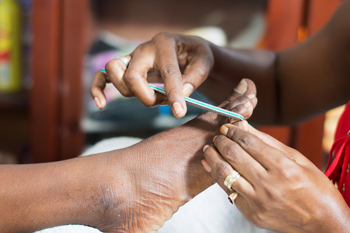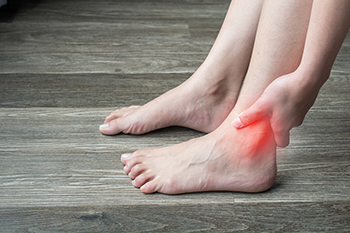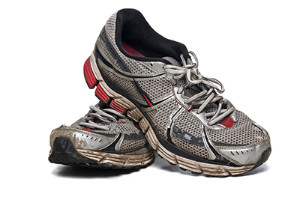Items filtered by date: October 2023
The Importance of Daily Foot Care

Our feet, often overlooked and underappreciated, are the unsung heroes that support your body every day. They endure a tremendous amount of stress and strain, yet it is common to neglect their care. Everyday foot care is not just a matter of comfort; it is a fundamental aspect of overall well-being. Neglecting foot health can lead to a host of problems, from painful calluses and ingrown toenails to more serious issues like fungal infections and chronic foot pain. Basic daily care involves washing and drying your feet, trimming toenails straight across, and wearing properly fitting shoes. Incorporating foot massages, stretches, and moisturizing into your routine can also enhance circulation and keep the skin supple. By taking a few minutes each day to care for your feet, you can maintain their health, prevent future problems, and ensure that they continue to support you in every step you take. There are a multitude of methods to maintain foot care. If you are interested in learning more about this, it is suggested that you visit a podiatrist who can guide you toward effective foot care techniques.
Everyday foot care is very important to prevent infection and other foot ailments. If you need your feet checked, contact one of our podiatrists from Itasca Foot & Ankle. Our doctors can provide the care you need to keep you pain-free and on your feet.
Everyday Foot Care
Often, people take care of their bodies, face and hair more so than they do for their feet. But the feet are a very important aspect of our bodies, and one that we should pay more attention to. Without our feet, we would not be able to perform most daily tasks.
It is best to check your feet regularly to make sure there are no new bruises or cuts that you may not have noticed before. For dry feet, moisturizer can easily be a remedy and can be applied as often as necessary to the affected areas. Wearing shoes that fit well can also help you maintain good foot health, as well as making it easier to walk and do daily activities without the stress or pain of ill-fitting shoes, high heels, or even flip flops. Wearing clean socks with closed shoes is important to ensure that sweat and bacteria do not accumulate within the shoe. Clean socks help to prevent Athlete’s foot, fungi problems, bad odors, and can absorb sweat.
If you have any questions please feel free to contact our offices located in Itasca and Hoffman Estates, IL . We offer the newest diagnostic and treatment technologies for all your foot and ankle needs.
What Shoes Should I Purchase for Work?

In the workplace, ensuring the safety of your feet is of great importance. Different job environments require various types of foot protection to prevent injuries and promote a secure working environment. Steel-toed boots are a popular choice in jobs like construction, manufacturing, and heavy equipment operation, as they shield against impacts and punctures. For those working with chemicals, waterproof boots with chemical-resistant materials offer protection against corrosive substances. Electricians and others exposed to electrical hazards can benefit from electrical hazard footwear that insulates against electric shock. Slip-resistant shoes are necessary in environments prone to spills or wet surfaces as they reduce the risk of slipping. Healthcare professionals often wear comfortable, slip-resistant shoes to maintain stability during long shifts. To determine the best shoe choice for your profession or to learn about the benefits of wearing work-appropriate shoes, it is suggested that you confer with a podiatrist.
While working on the feet, it is important to take the proper care of them. For more information about working on your feet, contact one of our podiatrists from Itasca Foot & Ankle. Our doctors will treat your foot and ankle needs.
Working on Your Feet
Standing on your feet for long periods of time can cause stress and pain in your feet. Your whole body may experience change in terms of posture, back pain, bunions, callouses and or plantar warts. There are ways to avoid these conditions with proper foot care, smart choices and correct posture.
Positive Changes
Negative heeled shoe – Choosing this shoe type places the heel slightly lower than the ball of the foot. These are great for overall foot health. Find shoes that fit you correctly.
Go barefoot – Our feet were not designed to be enclosed for all hours of the day. Try to periodically expose your feet to air.
Eliminate Pain
Foot Exercises – Performing simple exercises, incorporating yoga and doing stretches are beneficial. This will allow increased blood flow to the area and muscles of the foot.
Achilles tendon – Stretching the foot out flat on the floor will relax the calf muscles and tendon. These exercises can be performed almost anywhere. Make sure you add these exercises to your daily regimen.
With a little bit of this information and knowing more about foot health, you will notice changes. Foot stretches and proper footwear will help with pain and prevent further issues.
If you have any questions please feel free to contact our offices located in Itasca and Hoffman Estates, IL . We offer the newest diagnostic and treatment technologies for all your foot and ankle needs.
Are You Suffering From Ingrown Toenails?
How Osteoarthritis Can Affect the Ankle

Osteoarthritis, or OA, which is often associated with aging and wear-and-tear, isn't limited to just the knees and hips. It can also affect the ankle joint, causing pain and mobility issues. Osteoarthritis in the ankle is a chronic condition that develops when the protective cartilage that cushions the bones begins to deteriorate. OA can occur at any time of life, but it is most common in older adults. Being overweight adds stress to your ankles and fat cells produce proteins that may make the condition worse. Any ankle injury, even one that happened years ago, can lead to osteoarthritis. Symptoms include pain, stiffness, swelling, and a reduced range of motion, which can significantly affect your daily life. Even simple tasks like walking and climbing stairs can become challenging. Several factors can contribute to ankle osteoarthritis, including previous injuries, genetics, and obesity. Treatment options include medication, physical therapy, orthotic devices, and in some cases, surgery. Osteoarthritis is a progressive disease, and for that reason managing it requires a comprehensive approach to reduce pain and maintain mobility. It's suggested that you make an appointment with a podiatrist if you suspect osteoarthritis is affecting your ankles.
Arthritis can be a difficult condition to live with. If you are seeking treatment, contact one of our podiatrists from Itasca Foot & Ankle. Our doctors can provide the care you need to keep you pain-free and on your feet.
Arthritic Foot Care
Arthritis is a term that is commonly used to describe joint pain. The condition itself can occur to anyone of any age, race, or gender, and there are over 100 types of it. Nevertheless, arthritis is more commonly found in women compared to men, and it is also more prevalent in those who are overweight. The causes of arthritis vary depending on which type of arthritis you have. Osteoarthritis for example, is often caused by injury, while rheumatoid arthritis is caused by a misdirected immune system.
Symptoms
- Swelling
- Pain
- Stiffness
- Decreased Range of Motion
Arthritic symptoms range in severity, and they may come and go. Some symptoms stay the same for several years but could potentially get worse with time. Severe cases of arthritis can prevent its sufferers from performing daily activities and make walking difficult.
Risk Factors
- Occupation – Occupations requiring repetitive knee movements have been linked to osteoarthritis
- Obesity – Excess weight can contribute to osteoarthritis development
- Infection – Microbial agents can infect the joints and trigger arthritis
- Joint Injuries – Damage to joints may lead to osteoarthritis
- Age – Risk increases with age
- Gender –Most types are more common in women
- Genetics – Arthritis can be hereditary
If you suspect your arthritis is affecting your feet, it is crucial that you see a podiatrist immediately. Your doctor will be able to address your specific case and help you decide which treatment method is best for you.
If you have any questions, please feel free to contact our offices located in Itasca and Hoffman Estates, IL . We offer the newest diagnostic and treatment technologies for all your foot care needs.
Signs You May Need New Running Shoes

Runners know the importance of a good pair of shoes that help to clock in the miles comfortably and safely. But like any other piece of equipment, running shoes have a lifespan. If you are wondering whether it is time to bid farewell to your old shoes, here are some signs to look out for. First, pay attention to the wear and tear on the soles. If the treads are worn down, especially in specific areas, this can lead to reduced traction and increased risk of slipping or injury. Second, listen to your body. If you are experiencing unexplained pain in your feet, ankles, or knees, worn-out shoes could be the cause. They may no longer provide the necessary support and cushioning, which causes stress on your joints. Running shoes typically have a life span of 300 to 500 miles, depending on various factors. If you have surpassed this range, it is time to shop for a new pair. If you need guidance in the life span and safety of your running shoes, it is suggested that you make an appointment with a podiatrist for an evaluation.
Exercising your feet regularly with the proper foot wear is a great way to prevent injuries. If you have any concerns about your feet, contact one of our podiatrists of Itasca Foot & Ankle. Our doctors will treat your foot and ankle needs.
How to Prevent Running Injuries
Many common running injuries are caused by overuse and overtraining. When the back of the kneecap starts wearing out and starts causing pain in your knee, this is commonly referred to as runner’s knee. Runner’s knee is a decrease in strength in your quadriceps and can occur if you’re not wearing properly fitted or supporting shoes. To prevent runner’s knee, focusing on hip strengthening is a good idea, as well as strengthening your quads to keep the kneecaps aligned.
What Are Some Causes of Running Injuries?
- One cause of a common running injury is called iliotibial band syndrome.
- Plantar fasciitis is also another common injury.
- Stress fractures can occur from overtraining, lack of calcium, or even your running style.
Best Ways to Prevent Running Injuries
- Wear footwear that fits properly and suits your running needs.
- Running shoes are the only protective gear that runners have to safeguard them from injury.
- Make a training schedule. Adding strengthening exercises as well as regular stretching can help keep you strong and limber and can lessen the possibility of injuries.
- Stretching keeps muscles limber; this will help you gain better flexibility.
If you have any questions please feel free to contact our offices located in Itasca and Hoffman Estates, IL . We offer the newest diagnostic and treatment technologies for all your foot and ankle needs.
Causes and Treatment Options for Bunions

Bunions are bony bumps that form at the base of the big toe and are a common foot condition that can cause pain and discomfort. Bunions typically develop due to a combination of factors. Genetics plays a role, and if bunions run in your family, you may be more susceptible. Wearing ill-fitting shoes, especially those with narrow toe boxes or high heels, can exacerbate the condition. Overpronation, when the foot rolls inward excessively, and certain medical conditions, such as arthritis, can contribute to bunion formation. Symptoms of bunions often include pain, swelling, and redness at the base of the big toe. The big toe may also lean toward the other toes or overlap them. Corns and calluses can develop where the big toe rubs against the adjacent toes. Treatment options for bunions consist of lifestyle changes, including wearing wider and more comfortable shoes, custom orthotics or bunion pads. In more severe cases, surgical intervention may be necessary to realign the toe joint. By understanding bunions and seeking appropriate care from a podiatrist, individuals can effectively manage their symptoms and maintain foot health. If you have developed a bunion, it is strongly suggested that you consult with this type of doctor who can help you to manage this condition.
If you are suffering from bunion pain, contact one of our podiatrists of Itasca Foot & Ankle. Our doctors can provide the care you need to keep you pain-free and on your feet.
What Is a Bunion?
Bunions are painful bony bumps that usually develop on the inside of the foot at the joint of the big toe. As the deformity increases over time, it may become painful to walk and wear shoes. Women are more likely to exacerbate existing bunions since they often wear tight, narrow shoes that shift their toes together. Bunion pain can be relieved by wearing wider shoes with enough room for the toes.
Causes
- Genetics – some people inherit feet that are more prone to bunion development
- Inflammatory Conditions - rheumatoid arthritis and polio may cause bunion development
Symptoms
- Redness and inflammation
- Pain and tenderness
- Callus or corns on the bump
- Restricted motion in the big toe
In order to diagnose your bunion, your podiatrist may ask about your medical history, symptoms, and general health. Your doctor might also order an x-ray to take a closer look at your feet. Nonsurgical treatment options include orthotics, padding, icing, changes in footwear, and medication. If nonsurgical treatments don’t alleviate your bunion pain, surgery may be necessary.
If you have any questions, please feel free to contact our offices located in Itasca and Hoffman Estates, IL . We offer the newest diagnostic and treatment technologies for all your foot care needs.
